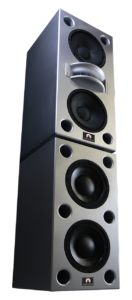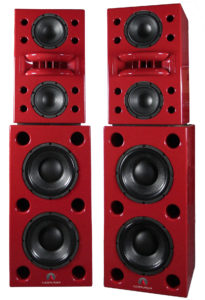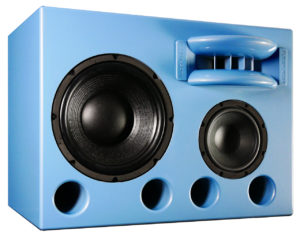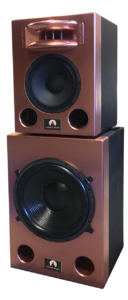Beryllium Diaphragms
The Mysteriously Musical Material Explained
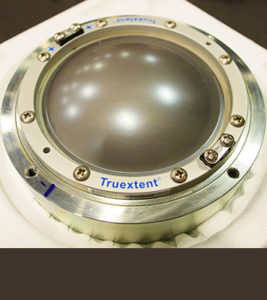 The other business end of the horn utilizes a massive 4” 99.5% pure beryllium diaphragm. We chose beryllium (#4 on the Periodic Table of Atomic Elements) as it is one of the lightest metals and has one of the highest melting points among the light metals – 2,348.6 degrees F or 1287 degrees C!To geek out a little more, beryllium's modulus of elasticity (or ratio of the stress to the strain!) is about one-third greater than steel, making it ideal for forming into a dome. Beryllium is nonmagnetic and even resistant to concentrated nitric acid. It also has superior thermal conductivity and resists oxidation in air in normal temperatures.But, perhaps most important of all, unlike other materials commonly used, beryllium dissipates vibrational energy (aka sound) very, very quickly. It is quite the opposite of a church bell, it hardly rings at all.So, when used as a diaphragm in a compression driver the sound reproduction is incredibly pure.
The other business end of the horn utilizes a massive 4” 99.5% pure beryllium diaphragm. We chose beryllium (#4 on the Periodic Table of Atomic Elements) as it is one of the lightest metals and has one of the highest melting points among the light metals – 2,348.6 degrees F or 1287 degrees C!To geek out a little more, beryllium's modulus of elasticity (or ratio of the stress to the strain!) is about one-third greater than steel, making it ideal for forming into a dome. Beryllium is nonmagnetic and even resistant to concentrated nitric acid. It also has superior thermal conductivity and resists oxidation in air in normal temperatures.But, perhaps most important of all, unlike other materials commonly used, beryllium dissipates vibrational energy (aka sound) very, very quickly. It is quite the opposite of a church bell, it hardly rings at all.So, when used as a diaphragm in a compression driver the sound reproduction is incredibly pure.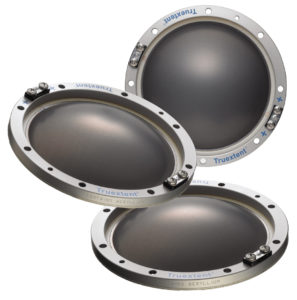 Acoustic Properties of Beryllium Beryllium is widely used for a variety of special applications which utilize one or more of beryllium's unique combination of properties including:
Acoustic Properties of Beryllium Beryllium is widely used for a variety of special applications which utilize one or more of beryllium's unique combination of properties including:- High stiffness to density ratio
- Good strength to density ratio
- High heat capacity and thermal conductivity
- High atomic scatter cross-section and low absorption cross-section
If you strike three identical tuning forks of Aluminum, Titanium, and Beryllium, you will hear decaying tones like those recorded and shown below.
You will notice the different frequencies, or pitches, at which they ring and the different durations of each tone. As we will show, these differences are due to the material properties of each fork.
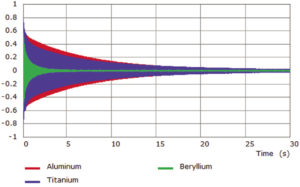 If we look at the Fourier Transform of those tones (below), we see the frequencies at which each tuning fork rings. Though much lower, these frequencies are analogous to those at which a speaker diaphragm of each material will begin to resonate or break-up. Beryllium rings at a frequency about 2.5x higher than aluminum and titanium (musically, this is more than an octave higher!). By analogy, if your 1” aluminum tweeter dome resonates at 22 kHz, then you can expect a similar beryllium tweeter to ring at over 50 kHz! Truextent Genuine Beryllium allows you to take full advantage of the extended bandwidth of today’s high-resolution audio.
If we look at the Fourier Transform of those tones (below), we see the frequencies at which each tuning fork rings. Though much lower, these frequencies are analogous to those at which a speaker diaphragm of each material will begin to resonate or break-up. Beryllium rings at a frequency about 2.5x higher than aluminum and titanium (musically, this is more than an octave higher!). By analogy, if your 1” aluminum tweeter dome resonates at 22 kHz, then you can expect a similar beryllium tweeter to ring at over 50 kHz! Truextent Genuine Beryllium allows you to take full advantage of the extended bandwidth of today’s high-resolution audio. 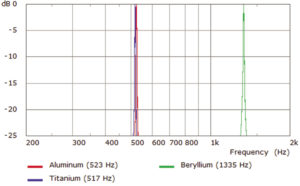 Also, we can use an Energy-Time Curve to see the loudness of each tone over time (below). This makes an easy calculation of the decay rate (dB/s) which tells us how well-damped each material is, or how quickly it will stop ringing. Note that Beryllium stops much faster than either Aluminum or Titanium, which ring for a very long time and are still audible after even 30 seconds!The moral of this story is: If you want a good tuning fork (or dinner bell), use Titanium or Aluminum, but if you want a good speaker diaphragm, use Beryllium.
Also, we can use an Energy-Time Curve to see the loudness of each tone over time (below). This makes an easy calculation of the decay rate (dB/s) which tells us how well-damped each material is, or how quickly it will stop ringing. Note that Beryllium stops much faster than either Aluminum or Titanium, which ring for a very long time and are still audible after even 30 seconds!The moral of this story is: If you want a good tuning fork (or dinner bell), use Titanium or Aluminum, but if you want a good speaker diaphragm, use Beryllium.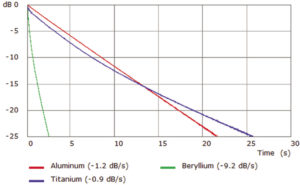 Our thanks to Materion Brush Inc. for the above data.For more information: www.materion.com/truextent , or simply download https://materion.com/-/media/files/electrofusion/a_truextent_info/ttb002_tuningforks.pdf
Our thanks to Materion Brush Inc. for the above data.For more information: www.materion.com/truextent , or simply download https://materion.com/-/media/files/electrofusion/a_truextent_info/ttb002_tuningforks.pdf Low Frequency Extension Cabs, aka : Subwoofers
Low Frequency Extension Cabs
 The lowest two or three octaves are among the most challenging to reproduce. The range of 20 Hz to 100 Hz requires ever more power and cone area as you go both lower and louder. Exponentially more. If 80 Hz is just over 14 ft. long, then 40 Hz is over 28 ft. long and 20 Hz is a remarkable 56.5 ft. long! It is difficult to reproduce these frequencies, especially at high SPL, without introducing unwanted artifacts, or distortion.Over the years smaller nearfield monitoring systems have been complemented by adding a subwoofer to help reproduce frequencies outside the main speakers’ capabilities and allow for this otherwise un-heard content to be observed. This approach has had varying success, owing to the need to know how to set them up correctly, as well as having some understanding of room acoustics and placement of loudspeakers in a room.Many subwoofers, even professional designs, lack the ability to articulate with precision the signal going into them. They merely put out a lot of low frequencies in a non-distinct rumble. Some notes are blurred, others barely present and still others are too loud, and in short the user is playing a guessing game. This is partly why subwoofers have a less than stellar reputation.At Augspurger® we prefer the term Low Frequency Extension Cabinet, as it describes much more what our intent is. With today’s modern recording chains and digital playback it is easy to create true stereo across all audible frequencies – 20 Hz to 20kHz. We feel it is imperative to offer the same high-quality, articulate, clean and dynamic performance from 20 to 100 Hz as we do for all the octaves above 100 Hz. It’s redefining what a subwoofer should do.
The lowest two or three octaves are among the most challenging to reproduce. The range of 20 Hz to 100 Hz requires ever more power and cone area as you go both lower and louder. Exponentially more. If 80 Hz is just over 14 ft. long, then 40 Hz is over 28 ft. long and 20 Hz is a remarkable 56.5 ft. long! It is difficult to reproduce these frequencies, especially at high SPL, without introducing unwanted artifacts, or distortion.Over the years smaller nearfield monitoring systems have been complemented by adding a subwoofer to help reproduce frequencies outside the main speakers’ capabilities and allow for this otherwise un-heard content to be observed. This approach has had varying success, owing to the need to know how to set them up correctly, as well as having some understanding of room acoustics and placement of loudspeakers in a room.Many subwoofers, even professional designs, lack the ability to articulate with precision the signal going into them. They merely put out a lot of low frequencies in a non-distinct rumble. Some notes are blurred, others barely present and still others are too loud, and in short the user is playing a guessing game. This is partly why subwoofers have a less than stellar reputation.At Augspurger® we prefer the term Low Frequency Extension Cabinet, as it describes much more what our intent is. With today’s modern recording chains and digital playback it is easy to create true stereo across all audible frequencies – 20 Hz to 20kHz. We feel it is imperative to offer the same high-quality, articulate, clean and dynamic performance from 20 to 100 Hz as we do for all the octaves above 100 Hz. It’s redefining what a subwoofer should do.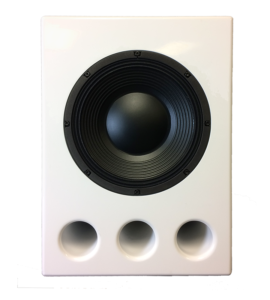 The traditional “add a subwoofer” approach is no longer a valid approach as the act of summing all low frequency content of both left and right channels into mono, only to be reproduced by a single device defeats the artist's intentions. Taking this approach means everything below the sub’s crossover point (usually between 85 and 120 Hz, or 3-4 octaves of information) is not being referenced correctly. Stereo musical content extends all the way to 20 Hz. Did you all hear that? Please let us say it again: Stereo musical content extends all the way to 20 Hz! A single sub is not going to give you stereo info.Many Augspurger® systems already go down quite low, typically below 40 Hz and ma,ny below 30 Hz, without adding additional cabinets. But for many, having the ability to resolve all the way down to 20 Hz is essential, and having it dynamically available means adding in two LF cabinets under each main cabinet and powering it with a very large, high quality amplifier. True full-range stereo sound reproduction. So, please don’t ask us for a single sub on your Augspurger® system! It’s just not right.
The traditional “add a subwoofer” approach is no longer a valid approach as the act of summing all low frequency content of both left and right channels into mono, only to be reproduced by a single device defeats the artist's intentions. Taking this approach means everything below the sub’s crossover point (usually between 85 and 120 Hz, or 3-4 octaves of information) is not being referenced correctly. Stereo musical content extends all the way to 20 Hz. Did you all hear that? Please let us say it again: Stereo musical content extends all the way to 20 Hz! A single sub is not going to give you stereo info.Many Augspurger® systems already go down quite low, typically below 40 Hz and ma,ny below 30 Hz, without adding additional cabinets. But for many, having the ability to resolve all the way down to 20 Hz is essential, and having it dynamically available means adding in two LF cabinets under each main cabinet and powering it with a very large, high quality amplifier. True full-range stereo sound reproduction. So, please don’t ask us for a single sub on your Augspurger® system! It’s just not right. Free-Standing vs. Flush-Mounting
What is best setup for your working and listening space
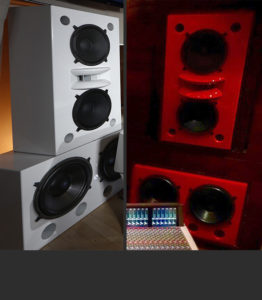 We know a thing or two about what makes a good sounding room good. We work closely with many of the world’s top studio designers and builders to ensure the room design will work and details are paid attention to.Room dimensions and geometry, front wall design, primary listening areas, acoustic treatments all need to work together to create a space that sounds real, solid and inspiring. After all, there’s a good possibility next year’s Grammy winners will be produced in Augspurger® rooms!Some basic considerations when choosing how in to install your Augspurger® monitor system include:
We know a thing or two about what makes a good sounding room good. We work closely with many of the world’s top studio designers and builders to ensure the room design will work and details are paid attention to.Room dimensions and geometry, front wall design, primary listening areas, acoustic treatments all need to work together to create a space that sounds real, solid and inspiring. After all, there’s a good possibility next year’s Grammy winners will be produced in Augspurger® rooms!Some basic considerations when choosing how in to install your Augspurger® monitor system include: - Do you own your space or are you leasing? Designing and building a front wall for flush (or soffit)-mounting can be expensive and take up a lot of space.
- Placement is crucial in achieving best sonic results. Again, it is imperative the front wall design be totally accurate, taking into consideration height, width, forward tilt angle (if any), and focus angle (just the mix position or mix plus producer in rear of room?), acoustic treatments and so much more. Once the speakers are mounted in the wall, there's not much chance of moving them!
- Benefits of a free-standing installation include smaller overall footprint, flexibility in fine-tuning positioning in room, lower overall buildout costs (and investment recoup should you need to relocate), and the ability to re-utilize the system more easily when you do relocate!
- Contact us to discuss best optins for your situation.
The Augspurger® Power Curve
How all system elements come together to deliver Breathtaking Power and Unmistakable Clarity
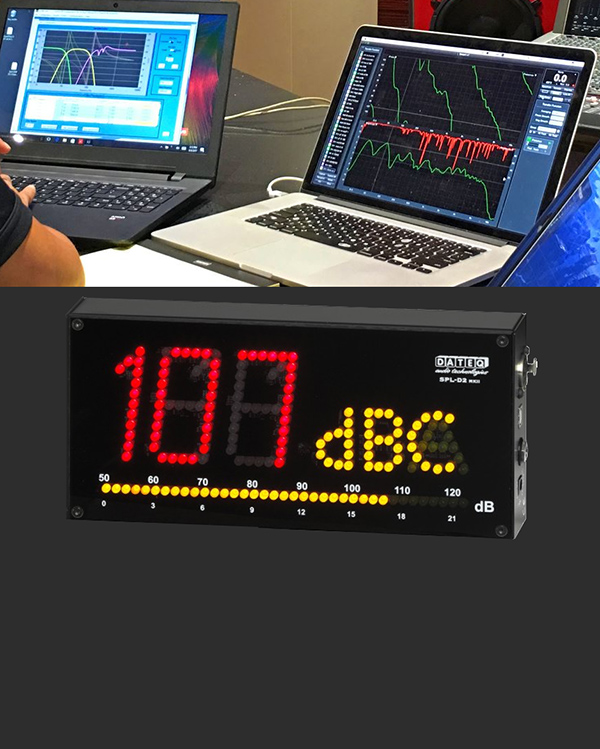 Many customers comment on how their workflow and listening habits are changed through their use of Augspurger® monitors. Of course, they love the thrill of club or concert level listening and the excitement of clean and accurate sound reproduction even when the volume goes up, up, up! Sure, some of our customers love to work at the extreme but just as many say they’ve actually been listening at lower levels than they used to.Why? Because Augspurger® monitors provide a full and realistic response at all levels. So, whether you want to work at 80dB, 100dB or even 120 dB you can count on accuracy, clarity and full balanced sound. When every component plays its part so perfectly, the “system” is realized. It’s like a great orchestra coming together – many instruments creating wonderful cohesive music and acting as one.The Augspurger® power curve allows you to resolve the quietest ppp passages and the loudest fff crescendos with total confidence. It is not an accident our systems receive high praise from top producers, artists, engineers and record labels worldwide.Our customers create and operate in the land of handcrafted artistry. And that's exactly how every Augspurger® system is conceived. Designed, built and tested in Hanover, MA USA.
Many customers comment on how their workflow and listening habits are changed through their use of Augspurger® monitors. Of course, they love the thrill of club or concert level listening and the excitement of clean and accurate sound reproduction even when the volume goes up, up, up! Sure, some of our customers love to work at the extreme but just as many say they’ve actually been listening at lower levels than they used to.Why? Because Augspurger® monitors provide a full and realistic response at all levels. So, whether you want to work at 80dB, 100dB or even 120 dB you can count on accuracy, clarity and full balanced sound. When every component plays its part so perfectly, the “system” is realized. It’s like a great orchestra coming together – many instruments creating wonderful cohesive music and acting as one.The Augspurger® power curve allows you to resolve the quietest ppp passages and the loudest fff crescendos with total confidence. It is not an accident our systems receive high praise from top producers, artists, engineers and record labels worldwide.Our customers create and operate in the land of handcrafted artistry. And that's exactly how every Augspurger® system is conceived. Designed, built and tested in Hanover, MA USA. Configuration Considerations
What system spec works best for you?
 Every AUGSPURGER® system is custom configured for the room it is going into, taking into account room volume, listening distance, placement, acoustic treatments and more to ensure the most accurate and exciting full-range sound reproduction, no matter the content being produced in that room.But, we’re not finished here. Our durable standard matte black and silver finishes fit elegantly into any environment and custom finishes can be ordered to match any décor and add to your personal vibe! If you like that lime green on your Lambo, you can have it on your speakers!If you've been dreaming of upgrading to a truly modern Augspurger® monitor system we know the decision making process can be daunting. That's why we enjoy nothing more than speaking with you - our prospective clients and hopeful members of the Augspurger® family - about which system configuration is best for you, your work, your room and your budget. We invite you to take advantage of our design expertise, acoustical resources, workflow planning and facilities layout experience. We live in the highest rule of audio production - you must trust what you hear!Every gesture and decision stems from your trust in your monitor system, from first mic placement to final mix print. Give us a call or drop us an email. We'd love to be part of your next exciting project. And to welcome you to the Augspurger® family. MORE PHOTOS:
Every AUGSPURGER® system is custom configured for the room it is going into, taking into account room volume, listening distance, placement, acoustic treatments and more to ensure the most accurate and exciting full-range sound reproduction, no matter the content being produced in that room.But, we’re not finished here. Our durable standard matte black and silver finishes fit elegantly into any environment and custom finishes can be ordered to match any décor and add to your personal vibe! If you like that lime green on your Lambo, you can have it on your speakers!If you've been dreaming of upgrading to a truly modern Augspurger® monitor system we know the decision making process can be daunting. That's why we enjoy nothing more than speaking with you - our prospective clients and hopeful members of the Augspurger® family - about which system configuration is best for you, your work, your room and your budget. We invite you to take advantage of our design expertise, acoustical resources, workflow planning and facilities layout experience. We live in the highest rule of audio production - you must trust what you hear!Every gesture and decision stems from your trust in your monitor system, from first mic placement to final mix print. Give us a call or drop us an email. We'd love to be part of your next exciting project. And to welcome you to the Augspurger® family. MORE PHOTOS: